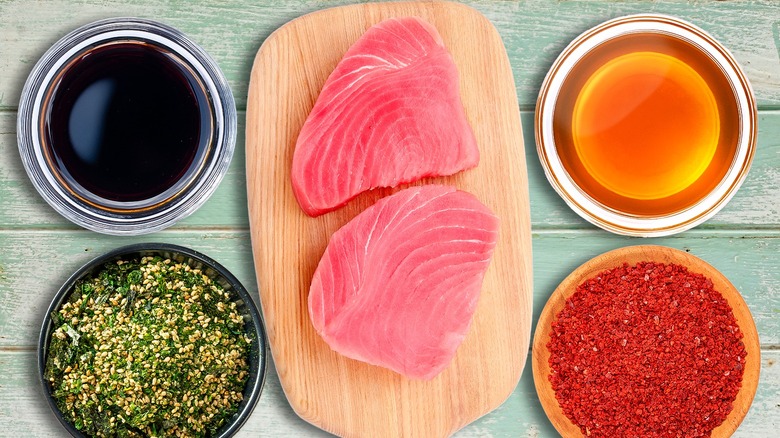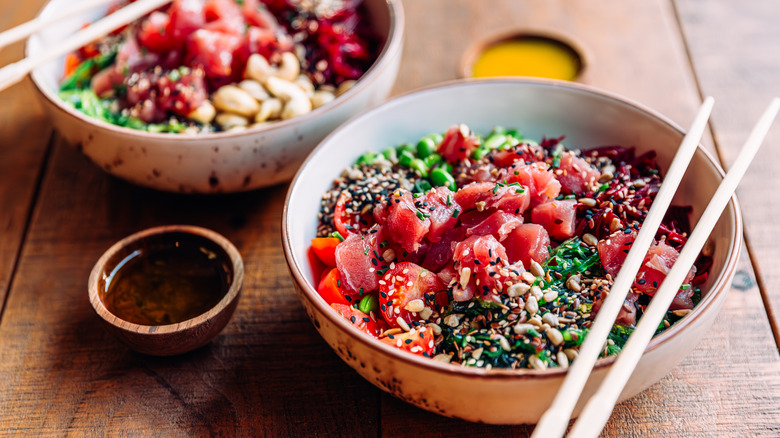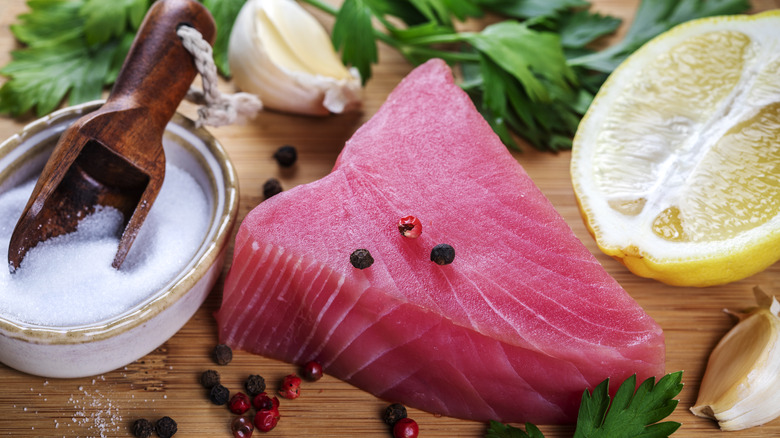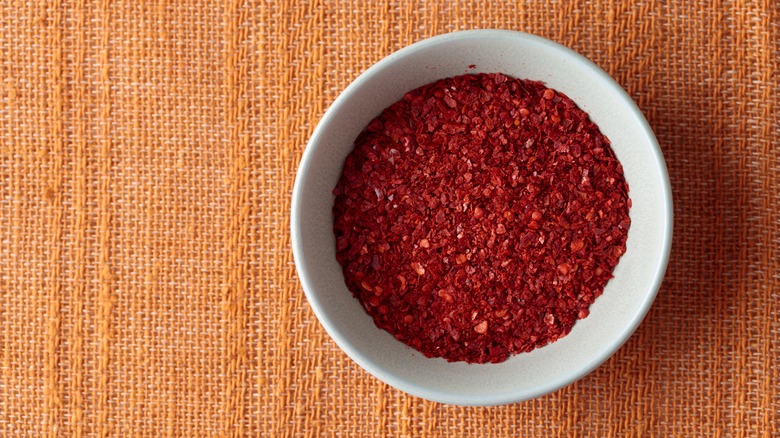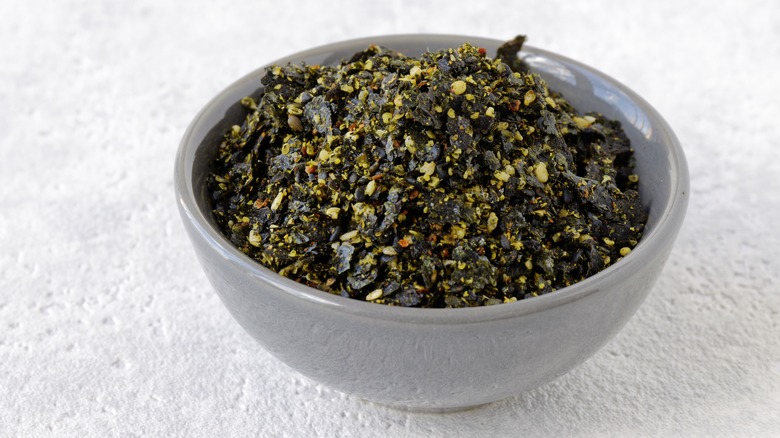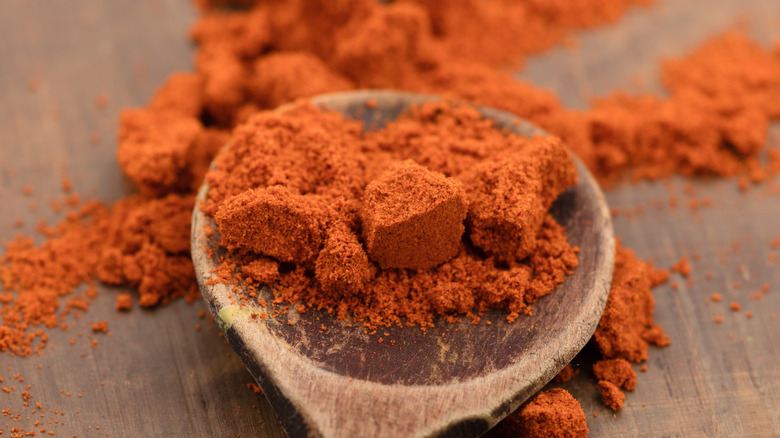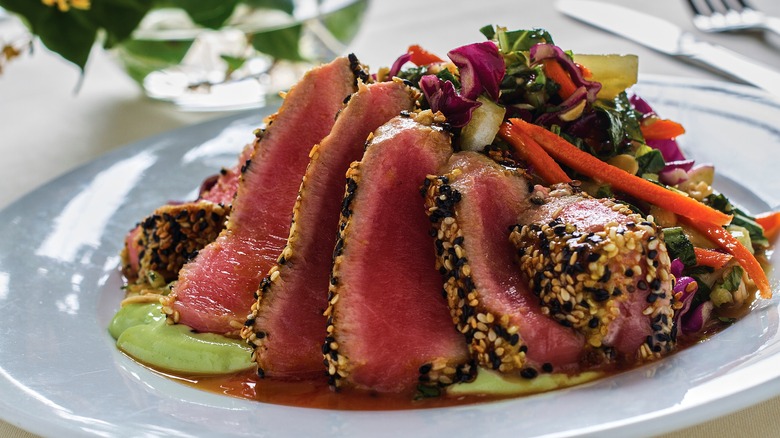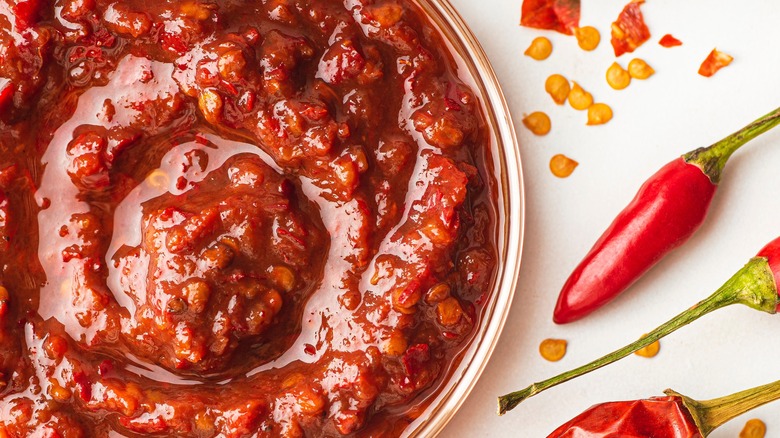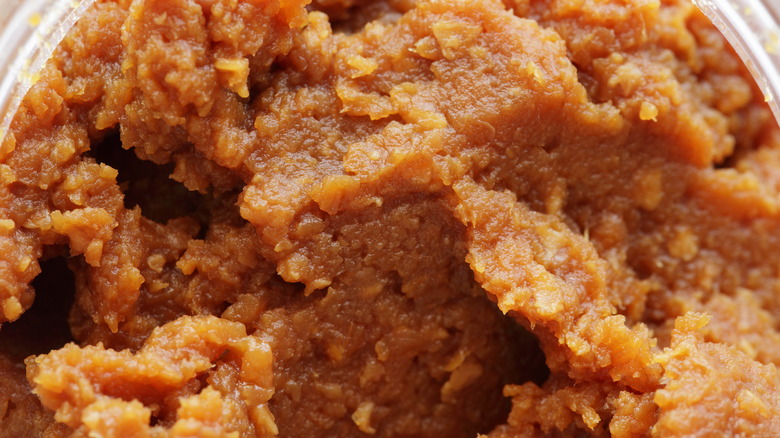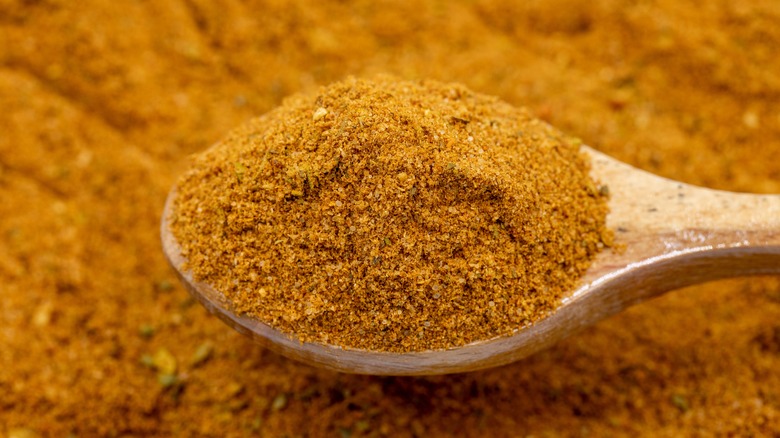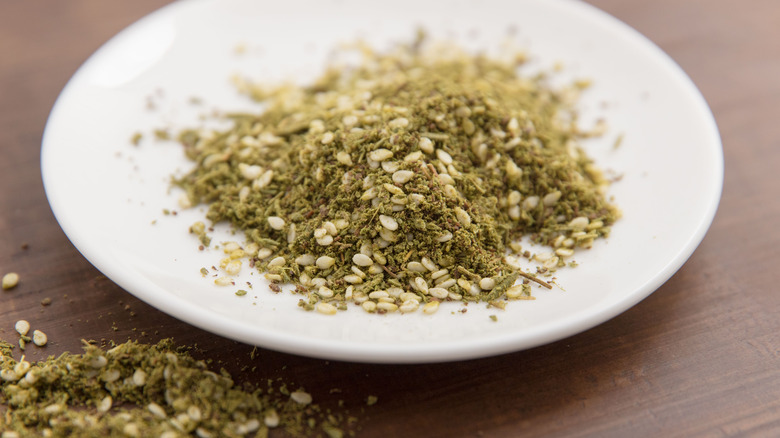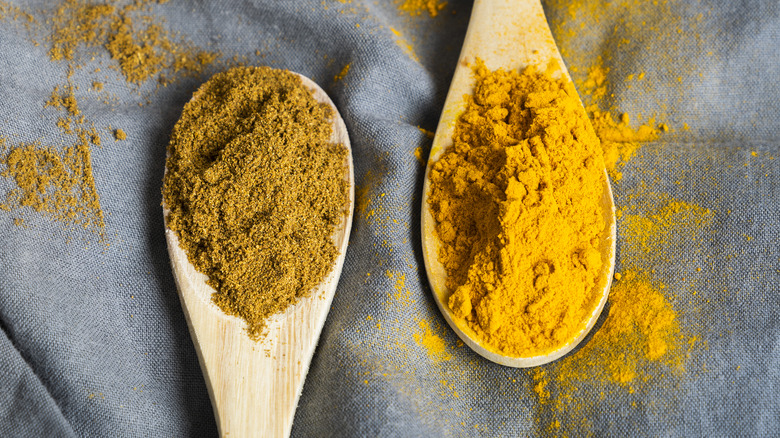12 Seasonings That Will Take Fresh Tuna To The Next Level
Fresh tuna is a versatile and flavorful fish that lends itself to a wide variety of culinary styles. From sushi-grade cuts to thick steaks perfect for grilling, tuna can be a blank canvas for countless flavor combinations. Whether raw, seared, or fully cooked, the right seasonings can truly elevate tuna from a simple dish to a gourmet experience. Its firm texture, mild flavor, and richness make it a perfect candidate for pairing with bold seasonings or subtle augments.
I've said it before, and I'll say it again: I've worked with a lot of different seafood in my career, and tuna is consistently one of my favorites. Its versatility alone makes it so easy to generate ideas for, you can whip something up for it with just about anything you have in the pantry. This guide covers 12 seasoning ideas I love to use at home that will take your tuna to the next level.
Whether you're preparing tuna for a poke bowl or a seared steak, the seasonings listed here are designed to complement tuna's natural flavors while adding depth. Experimenting with these flavor combinations will help you create tuna dishes that are both exciting and satisfying. So, let's dive into these 12 seasonings and how each one can uplift fresh tuna, no matter how you plan to serve it.
Classic soy sauce and ginger
Soy sauce and ginger have long been celebrated as a classic pairing for fresh tuna. Their harmonious blend of umami from the soy sauce and zesty brightness from the ginger creates a balance that elevates the natural flavors of the fish. Soy sauce, with its fermented, salty richness, enhances the umami character of tuna, while ginger's slight heat and sharpness cut through the richness, adding a refreshing note.
For those making poke bowls or tuna tartare, a simple dressing of soy sauce mixed with grated raw ginger can work wonders. Adding a few drops of sesame oil or rice vinegar to the mix adds even more depth. The combination also works well when marinating tuna steaks before a quick sear. The salt in the soy sauce draws out moisture, helping to create a caramelized crust when cooked on high heat.
Soy sauce and ginger are essential ingredients in Japanese cuisine, particularly in raw dishes like sashimi. They allow the purity of the tuna to shine through while adding an extra layer of complexity. If you prefer a bit of heat, add a dash of wasabi or chili flakes to the soy-ginger combo for an extra kick.
Citrus zest and black pepper
For a lively twist, consider the bright, zesty notes of citrus zest paired with the warmth of cracked black pepper. Citrus zest — whether from lemons, limes, or oranges — injects a burst of brightness that contrasts adeptly with tuna's meatiness, while black pepper adds warmth and licks of spice without overpowering the dish. This combination is particularly suited for raw preparations like ceviche, where the acidity from the citrus lightly "cooks" the tuna, preserving its tenderness while infusing it with vibrant flavor.
The zest provides not just acidity but also aromatic oils that are released when finely grated. These oils add another dimension to the flavor, working best when rubbed into the tuna just before cooking or marinating. Pair this with cracked black pepper to add a sharp, spicy edge that enriches the texture of the tuna when seared or grilled.
This duo can also be used in marinades, where the acidity of citrus juice — balanced by the zest — helps to tenderize the fish. When serving raw tuna, a light drizzle of citrus juice and a sprinkle of zest offer a refreshing burst that highlights the natural sweetness of the fish. Add a touch of sea salt to bring everything together.
Sesame oil and gochugaru
To give fresh tuna a distinctly Korean twist, sesame oil and gochugaru are perfect pairings. Toasted sesame oil, known for its nutty, aromatic richness, serves as an excellent base for better tuna, while gochugaru, or Korean chili flakes, introduces a mild, smokey heat that builds layers of flavor without overwhelming the fish's natural flavor. Sesame oil provides a smooth, velvety mouthfeel that rounds off the firm, silky texture of tuna, and the light heat of gochugaru adds just enough warmth to make the dish exciting.
To make the most of this combo, drizzle a light coating of sesame oil over thinly sliced, sashimi-style tuna and sprinkle with a liberal pinch of gochugaru. This preparation is fantastic for raw tuna dishes, as the sesame oil adds a layer of richness that complements the clean, meaty flavor of the fish. The nutty aroma from the oil also plays off the slow-building heat from gochugaru, creating a harmonious dish that's both satisfying and packed with flavor.
If you're cooking your tuna, use sesame oil as the foundation for a marinade. Mix it with soy sauce, garlic, and a touch of honey. Let it marinate for at least 30 minutes to allow the flavors to penetrate. You get a caramelized crust that locks in moisture while delivering a flavorful punch with each bite. You can even finish the dish with a sprinkle of toasted sesame seeds for added texture and nuttiness.
Furikake seasoning
Furikake is a Japanese condiment that brings a combination of savory, crunchy, and slightly sweet flavors to any dish. Made from a mix of sesame seeds, seaweed, salt, sugar, and sometimes dried bonito flakes, furikake is a go-to seasoning for adding texture and umami to tuna. The saltiness of the seasoning helps to draw out the tuna's natural flavors, while the sesame seeds add a subtle crunch.
Furikake is commonly used in Japan to top rice, but it also works well on tuna. Sprinkle furikake on top of tuna poke bowls to add textural contrast to the tender, raw fish, or use it as a crust for seared tuna steaks. The sesame seeds in the furikake will toast as the tuna sears, providing a nutty flavor and crispy texture that complements the soft interior of the fish.
You can also twirl furikake with soy sauce and mirin for a quick marinade that infuses the tuna with umami-rich flavors before cooking. Whether you're preparing raw tuna dishes or seared steaks, furikake adds a multi-dimensional flavor that brings out the best in the fish while offering visual appeal with its speckled mix of colors and textures.
Smoked paprika and garlic powder
Nothing adds depth quite like barbecue's tried-and-true pairing of smoked paprika and garlic powder. Smoked paprika, derived from dried, smoked peppers, adds a smokey and slightly sweet undertone to tuna, making it an ideal option for grilling or broiling. The garlic powder, on the other hand, introduces a savory, slightly pungent kick to the mix.
Mix equal parts smoked paprika and garlic powder, then season the tuna generously before cooking. If you're searing or grilling the tuna, the high heat will allow the smoked paprika to develop a beautiful crust, giving the exterior a slightly charred, smoky edge while keeping the interior tender. The garlic powder will add a savory bite that adds to the tuna's natural flavor. You can elevate the dish further by incorporating a pinch of cayenne pepper or ground cumin into the seasoning mix to add an extra layer of complexity.
This seasoning duo works exceptionally well in broiled dishes, where the dry heat brings out the natural oils in the paprika, creating a smoky crust. Add a touch of olive oil or melted butter to help the spices adhere to the tuna and prevent it from drying out during cooking. For a finishing touch, squeeze a bit of lemon juice over the tuna after it's cooked — the citrus will brighten the smokey and savory notes, balancing out the richness of the fish.
Wasabi and ponzu
For a bold contrast of heat and acidity, wasabi and ponzu are a dynamic duo that deepens tuna's clean, fresh taste. Wasabi, known for its sharp, sinus-clearing heat, pairs deftly with ponzu, a Japanese sauce made from citrus juice and soy sauce. Together, they create a balanced flavor profile that works well for both raw and lightly seared tuna.
To use, mix ponzu with a small amount of wasabi to create a dipping sauce for tuna sashimi or poke. The tangy, salty ponzu serves as a foil to the mild, buttery texture of the raw tuna, while the heat from the wasabi adds a kick that awakens the palate. For a more robust dish, use ponzu as a marinade for seared tuna steaks and serve with a dollop of wasabi on the side.
The tangy, citrusy flavors of ponzu help to cut through the richness of the tuna, while the wasabi adds a sharp, spicy bite that keeps the dish balanced. This combination is perfect for those who enjoy a bit of heat with their seafood but don't want to overwhelm the natural flavor of the fish.
Lemon pepper and fresh herbs
Lemon pepper is a versatile seasoning that pairs wonderfully with herbs to create a bright and aromatic flavor profile for tuna. The zesty, tangy notes of lemon pepper combined with the herbal freshness of dill, parsley, or cilantro elevate tuna, making it feel light and cool while still full of flavor. This mix works particularly well for pan-seared or grilled tuna, where the heat helps to release the oils from the herbs and the zest from the lemon.
For an easy yet flavorful preparation, rub plenty of lemon pepper onto your tuna steaks along with a mixture of chopped fresh herbs. The acidity from the lemon pepper brightens up the tuna, while the herbs add an earthy complexity that rounds out the dish. You can also mix lemon pepper with olive oil and lemon juice to create a marinade that infuses the tuna with tangy, citrusy notes before cooking.
Dill or parsley can also be used as a garnish for raw tuna dishes, adding a touch of herbaceousness and visual brightness to this otherwise color-binary seasoning. This duo is perfect for those looking for a simple, light seasoning that brings out the best in tuna without overpowering it.
Harissa paste
Harissa, a North African chili paste made from roasted red peppers, garlic, and spices, brings a fiery heat and complex flavor to fresh tuna. The smoky, spicy character of harissa pairs well with the rich, meaty texture of tuna, creating a dish that's bold and full of depth. Harissa can be used as a marinade, a glaze, or a dipping sauce, making it a versatile seasoning for both raw and cooked tuna.
To use harissa with tuna, mix the paste with olive oil and a squeeze of lemon juice to create a marinade that adds both heat and acidity to the fish. Let the tuna marinate for at least 30 minutes before grilling or pan-searing. The heat from the harissa will intensify as the tuna cooks, creating a slightly charred, spicy crust that contrasts well with the tender, moist interior.
Harissa can also be used as a glaze for seared tuna, brushed on during the final minutes of cooking to add a glossy, flavorful finish. For raw tuna, harissa can be thinned out with a bit of olive oil and lemon juice to create a spicy sauce that drizzles over the tuna. This seasoning is perfect for those who enjoy bold, sharp flavors and want to add a touch of North African flair to their tuna dishes.
Miso paste and honey
Miso, a fermented soybean paste from Japan, swirled with honey, creates a sweet-savory glaze that elevates the natural flavors of fresh tuna. Miso's salty, umami-rich character offers a depth of flavor that pairs beautifully with the sweetness of honey, making this combination a standout choice for broiled or pan-seared tuna. The fermented miso adds a complex, savory undertone, while the honey provides a hint of sweetness, allowing the glaze to balance both flavor and texture. Together, they complement tuna's mild, clean flavor without overpowering its natural qualities.
To prepare, mix equal parts miso paste and honey, then spread the mixture generously over the tuna before cooking. You can also add a splash of rice vinegar or a dash of soy sauce to enhance the umami depth. As the tuna broils or sears, the glaze caramelizes, creating a slightly crispy, golden crust that contrasts beautifully with the tender, juicy interior. This caramelization adds a rich, sticky finish that highlights the savory-sweet balance of the dish, making each bite flavorful and satisfying.
Miso and honey are particularly well-suited for broiled tuna steaks, where the intense heat brings out the complex flavors, but they also work wonderfully with pan-seared tuna or even as a marinade for raw tuna in poke bowls or sashimi-style preparations. This combination offers a simple, yet elegant way to transform tuna into a delicious, flavor-packed dish, perfect for any occasion.
Blackening spice mix
For a Cajun-inspired twist, try using a blackening spice mix to season your tuna. This blend typically includes paprika, cayenne pepper, garlic powder, onion powder, thyme, and oregano, creating a bold, spicy crust when seared at high heat. Blackening seasoning adds a layer of flavor that pairs well with tuna's meaty texture, making it perfect for those who enjoy a bit of heat.
To use this seasoning, coat the tuna liberally with the blackening spice mix before searing in a hot skillet. The high heat will create a flavorful crust on the outside, while the inside remains tender and juicy. This technique works best for thick tuna steaks that can stand up to the intense heat and bold flavors of the blackening seasoning.
Blackening spices offer a bold and spicy seasoning option that's ideal for grilled or pan-seared tuna. The smokey heat from the spices tangoes seamlessly with the tender fish, creating a dynamic and flavorful dish.
Sumac and olive oil
Sumac, a tangy spice popular in Middle Eastern cuisine, adds a lemony brightness to fresh tuna that's both unique and earthy. Paired with high-quality olive oil, sumac creates a seasoning that enhances tuna's natural flavor without overpowering it. This pair is the highlight of za'atar and is particularly well-suited for grilled tuna steaks, where the heat helps to release the fragrant oils from the sumac and olive oil.
To prepare, rub olive oil over the tuna and sprinkle generously with sumac before grilling. The sumac's tangy flavor brightens the dish, while the olive oil adds richness and helps to keep the tuna moist during cooking. This pairing is also great for raw tuna dishes like tartare, where the sumac adds a pop of acidity that brightens the tuna's texture.
Sumac and olive oil offer a light, tangy seasoning option that's perfect for those who want to add a Mediterranean twist to their tuna dishes. The lemony flavor of the sumac pairs beautifully with tuna's natural richness, making it taste like it's fresh out of the Mediterranean.
Curry
Tuna pairs exceptionally well with curry, and the wide range of curry styles across different cuisines gives you plenty of options for spicing up your tuna dishes. Whether you're using a Thai green curry paste, an Indian-style curry powder, or a Caribbean jerk seasoning, curry adds layers of flavor that complement tuna's meaty texture.
For a simple preparation, marinate tuna steaks in a mixture of curry paste or powder, coconut milk, and lime juice before grilling or pan-searing. The tuna absorbs the rich flavors of the curry, creating a dish that's full of warmth and depth. You can also use curry as a sauce for raw or seared tuna, drizzling it over the top for a burst of bold flavor.
Curry offers a diverse range of seasoning options for tuna, making it an excellent choice for those who love spice and want to explore different flavor profiles. From Thai to Indian to Caribbean, curry brings out the best in tuna, adding a bold and flavorful twist to any dish.
